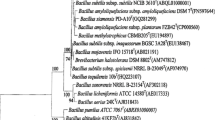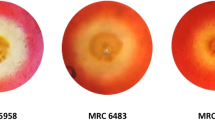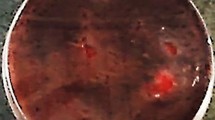Abstract
A cellulase-producing bacterium, designated as strain AK9, was isolated from a hot spring of Tatta Pani, Azad Kashmir, Pakistan. The bacterium was identified as Bacillus amyloliquefaciens through 16S rRNA sequencing. Cellulase from strain AK9 was able to liberate glucose from soluble cellulose and carboxymethyl cellulose (CMC). Enzyme was purified through size exclusion chromatography and a single band of ∼47 kDa was observed on sodium dodecyl sulfate-polyacrylamide gel electrophoresis (SDS-PAGE). The enzyme was purified with recovery of 35.5%, 3.6-fold purity with specific activity of 31 U mg−1. The purified cellulase retained its activity over a wide range of temperature (50–70 °C) and pH (3–7) with maximum stability at 60 °C and pH 5.0. The activity inhibited by ethylenediaminetetraacetic acid (EDTA), suggested that it was metalloenzyme. Diethyl pyrocarbonate (DEPC) and β-mercaptoethanol significantly inhibited cellulase activity that revealed the essentiality of histidine residues and disulfide bonds for its catalytic function. It was stable in non-ionic surfactants, in the presence of various metal ions, and in water-insoluble organic solvents. Approximately 9.1% of reducing sugar was released after enzymatic saccharification of DAP-pretreated agro-residue, compared to a very low percentage by autohydrolysis treatment. Hence, it is concluded that cellulase from B. amyloliquefaciens AK9 can potentially be used in bioconversion of lignocellulosic biomass to fermentable sugars.




Similar content being viewed by others
References
Patagundi, B. I., Shivasharan, C. T., & Kaliwal, B. B. (2014). Isolation and characterization of cellulase producing bacteria from soil. International Journal of Current Microbiology and Applied Sciences, 3, 59–69.
Zhang, G., Li, S., Xue, Y., Mao, L., & Ma, Y. (2012). Effects of salts on activity of halophilic cellulase with glucomannanase activity isolated from alkaliphilic and halophilic Bacillus sp. BG-CS10. Extremophiles, 16, 35–43.
Acharya, S., & Chaudhary, A. (2012). Alkaline cellulase produced by a newly isolated thermophilic Aneurinibacillus thermoaerophilus WBS2 from hot spring, India. African Journal Microbiology Research, 6, 5453–5458.
Kazue, T., Okuno, M., Furumoto, M., & Watanabe, H. (2006). Biomineralization of pisoliths in hot springs. Materials Science and Engineering, 26, 617–623.
Abdel-Fattah, Y. R., El-Helow, E. R., Ghanem, K. M., & Lotfy, W. A. (2007). Application of factorial designs for optimization of avicelase production by a thermophilic Geobacillus isolate. Research Journal of Microbiology, 2, 13–23.
Lee, Y. J., Kim, B. K., Lee, B. H., Jo, K. I., Lee, N. K., & Chung, C. H. (2008). Purification and characterization of cellulase produced by Bacillus amyoliquefaciens DL-3 utilizing rice hull. Bioresource Technology, 99, 378–386.
Rastogi, G., Muppidi, G. L., Gurram, R. N., Adhikari, A., Bischoff, K. M., & Hughes, S. R. (2009). Isolation and characterization of cellulose-degrading bacteria from the deep subsurface of the Homestake gold mine, Lead, South Dakota, USA. Journal of Industrial Microbiology & Biotechnology, 36, 585–598.
Jaradat, Z., Dawagreh, A., Ababneh, Q., & Saadoun, I. (2008). Influence of culture conditions on cellulase production by Streptomyces sp. (Strain J2). Jordan Journal Biological, Sciences, 1, 141–146.
Shah, A. A., Eguchi, T., Mayumi, D., Kato, S., Shintani, N., & Kamini, N. R. (2013). Purification and properties of novel aliphatic-aromatic co-polyesters degrading enzymes from newly isolated Roseateles depolymerans strain TB-87. Polymer Degradation and Stability, 98, 609–618.
Ghose, T. K. (1987). Measurement of cellulase activities. Pure and Applied Chemistry, 59, 257–268.
Lowry, O. H., Roserough, N. J., Farr, A. L., & Randall, R. J. (1951). Protein measurement with folin phenol reagent. The Journal of Biological Chemistry, 93, 265–275.
Ariffin, H., Abdullah, N., Umi, K., Shirai, Y., & Hassan, M. A. (2006). Production and characterization by Bacillus pumilus EB3. International Journal Engineering Technology, 3, 47–53.
Laemmli, U. K. (1970). Cleavage of structural proteins during the assembly of the head of bacteriophage T4. Nature, 227, 680–685.
Steel, R., Torrie, J., & Dickey, D. (1996). Principles and procedures of statistics: a biometrical approach (3rd ed.). New York: Pub: McGraw Hill Book Co Inc..
Zar, J. H. (1974). Biostatistical analysis (p. 620). Prentice Hall: Pub: Englewood Cliffs.
Meng, F., Ma, L., Ji, S., Yang, W., & Cao, B. (2014). Isolation and characterization of Bacillus subtilis strain BY-3, a thermophilic and efficient cellulase-producing bacterium on untreated plant biomass. Letters in Applied Microbiology, 59, 306–312.
Rawat, R., & Tewari, L. (2012). Purification and characterization of an acidothermophilic cellulase enzyme produced by Bacillus subtilis strain LFS3. Extremophiles, 16, 637–644.
Yassien, M. A. M., Jiman-Fatani, A. A. M., & Asfour, H. Z. (2014). Production, purification and characterization of cellulase from Streptomyces sp. African Journal Micrbiology Research, 8, 348–354.
El-Sersy, N. A., Abd-Elnaby, H., Abou-Elela, G. M., Ibrahim, H. A. H., & Toukhy, N. M. (2010). Optimization, economization and characterization of cellulase produced by marine Streptomyces ruber. African Journal Biotechnology, 9, 6355–6364.
Da Vinha, F. N. M., Gravina-Oliveira, M. P., Franco, M. N., Macrae, A., Da Silva Bon, E. P., & Nascimento, R. P. (2011). Cellulase production by Streptomyces viridobrunneus SCPE-09 using lignocellulosic biomass as inducer substrate. Applied Biochemistry and Biotechnology, 164, 256–267.
Akbar, S., Hasan, F., Nadhman, A., Khan, S., & Shah, A. A. (2013). Production and purification of poly(3-hydroxybutyrate-co-3-hydroxyvalerate) degrading enzyme from Streptomyces sp. AF-111. Journal of Polymers and the Environment, 21, 1109–1116.
Vijayaraghavan, P., & Vincent, S. G. P. (2012). Purification and characterization of carboxymethyl cellulase from Bacillus sp. isolated from a paddy field. Polish Journal Microbiology, 61, 51–55.
Rastogi, G., Bhalla, A., Adhikari, A., Bischoff, K. M., Hughes, S. R., & Christopher, L. P. (2010). Characterization of thermostable cellulases produced by Bacillus and Geobacillus strains. Bioresource Technology, 101, 8798–8806.
Asha, M. B., Revathi, M., Yadav, A., & Sakthivel, N. (2012). Purification and characterization of a thermophilic cellulase from a novel cellulolytic strain, Paenibacillus barcinonensis. Journal of Microbiology and Biotechnology, 22, 1501–1509.
Ogawa, A., Suzumatsu, A., Takizawa, S., Kubota, H., Sawada, K., & Hakamada, Y. (2007). Endoglucanase from Paenibacillus spp. from a new clan in glycoside hydrolase family 5. Journal of Biotechnology, 129, 406–414.
Han, S. J., Yoo, Y. J., & Kang, H. S. (1995). Characterization of bifunctional cellulase and its structural gene. The cell gene of Bacillus sp. D04 has exo and endoglucanase activity. The Journal of Biological Chemistry, 270, 26012–26019.
Kim, C. H. (1995). Characterization and substrate specificity of an endo-β-1,4-D-glucanase I (avicelase) from an extracellular multienzyme complex of Bacillus circulans. Applied and Environmental Microbiology, 61, 959–965.
Annamalai, N., Rajeswari, M. V., Elayaraja, S., & Balasubramanian, T. (2013). Thermostable, haloalkaline cellulase from Bacillus halodurans CAS 1 by conversion of lignocellulosic wastes. Carbohydrate Polymers, 94, 409–415.
Zaks, A., & Klibanov, A. M. (1988). Enzymatic catalysis in nonaqueous solvents. The Journal of Biological Chemistry, 263, 3194–3201.
Gaur, R., & Tiwar, S. (2015). Isolation, production, purification and characterization of an organic-solvent-thermostable alkalophilic cellulase from Bacillus vallismortis RG-07. BMC Biotechnology, 15, 19.
Author information
Authors and Affiliations
Corresponding author
Rights and permissions
About this article
Cite this article
Irfan, M., Tayyab, A., Hasan, F. et al. Production and Characterization of Organic Solvent-Tolerant Cellulase from Bacillus amyloliquefaciens AK9 Isolated from Hot Spring. Appl Biochem Biotechnol 182, 1390–1402 (2017). https://doi.org/10.1007/s12010-017-2405-8
Received:
Accepted:
Published:
Issue Date:
DOI: https://doi.org/10.1007/s12010-017-2405-8




